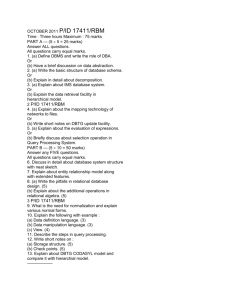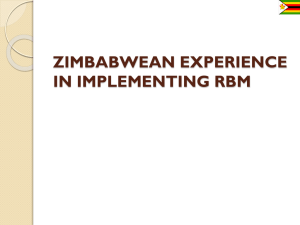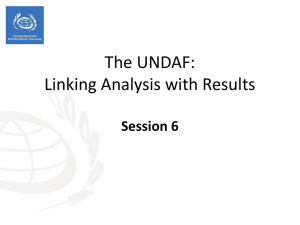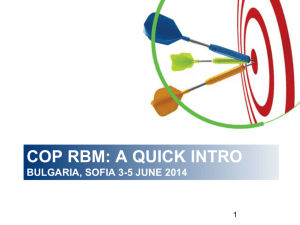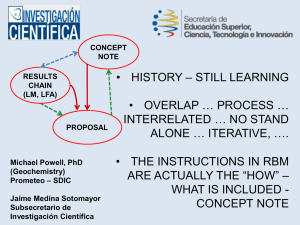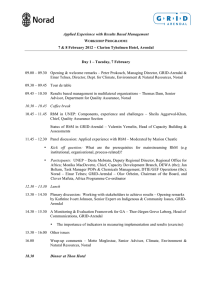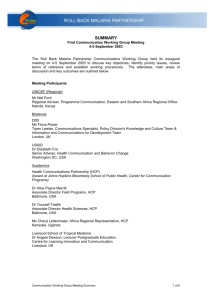Document 10467314
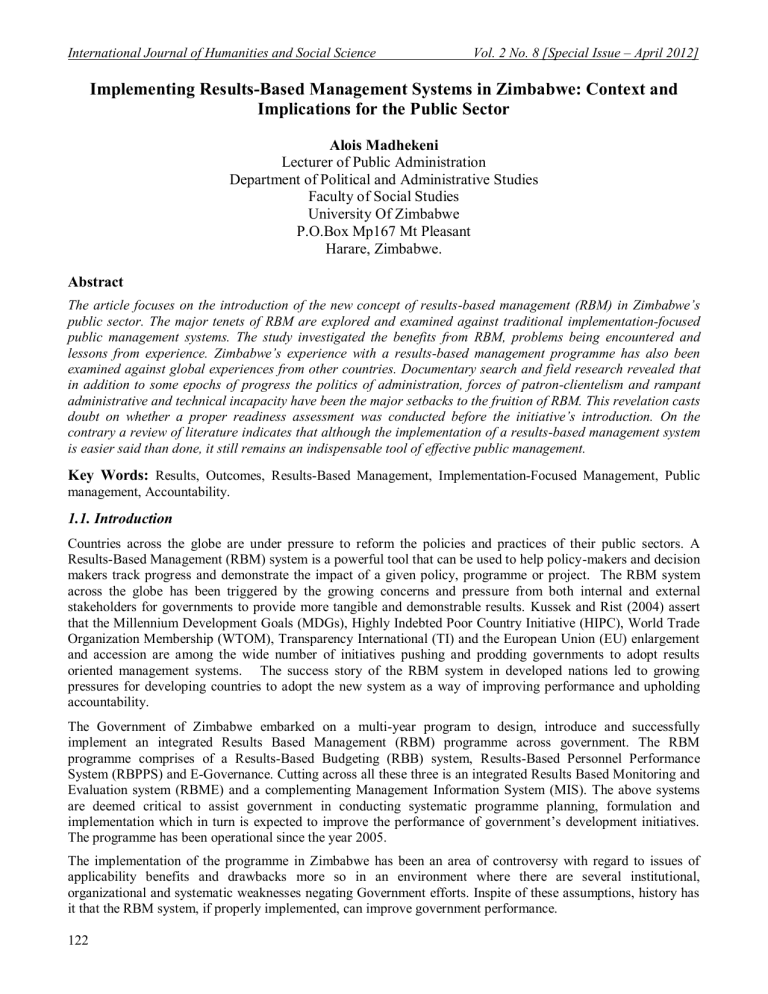
International Journal of Humanities and Social Science Vol. 2 No. 8 [Special Issue – April 2012]
Implementing Results-Based Management Systems in Zimbabwe: Context and
Implications for the Public Sector
Alois Madhekeni
Lecturer of Public Administration
Department of Political and Administrative Studies
Faculty of Social Studies
University Of Zimbabwe
P.O.Box Mp167 Mt Pleasant
Harare, Zimbabwe.
Abstract
The article focuses on the introduction of the new concept of results-based management (RBM) in Zimbabwe’s public sector. The major tenets of RBM are explored and examined against traditional implementation-focused public management systems. The study investigated the benefits from RBM, problems being encountered and lessons from experience. Zimbabwe’s experience with a results-based management programme has also been examined against global experiences from other countries. Documentary search and field research revealed that in addition to some epochs of progress the politics of administration, forces of patron-clientelism and rampant administrative and technical incapacity have been the major setbacks to the fruition of RBM. This revelation casts doubt on whether a proper readiness assessment was conducted before the initiative’s introduction. On the contrary a review of literature indicates that although the implementation of a results-based management system is easier said than done, it still remains an indispensable tool of effective public management.
Key Words:
Results, Outcomes, Results-Based Management, Implementation-Focused Management, Public management, Accountability.
1.1. Introduction
Countries across the globe are under pressure to reform the policies and practices of their public sectors. A
Results-Based Management (RBM) system is a powerful tool that can be used to help policy-makers and decision makers track progress and demonstrate the impact of a given policy, programme or project. The RBM system across the globe has been triggered by the growing concerns and pressure from both internal and external stakeholders for governments to provide more tangible and demonstrable results. Kussek and Rist (2004) assert that the Millennium Development Goals (MDGs), Highly Indebted Poor Country Initiative (HIPC), World Trade
Organization Membership (WTOM), Transparency International (TI) and the European Union (EU) enlargement and accession are among the wide number of initiatives pushing and prodding governments to adopt results oriented management systems. The success story of the RBM system in developed nations led to growing pressures for developing countries to adopt the new system as a way of improving performance and upholding accountability.
The Government of Zimbabwe embarked on a multi-year program to design, introduce and successfully implement an integrated Results Based Management (RBM) programme across government. The RBM programme comprises of a Results-Based Budgeting (RBB) system, Results-Based Personnel Performance
System (RBPPS) and E-Governance. Cutting across all these three is an integrated Results Based Monitoring and
Evaluation system (RBME) and a complementing Management Information System (MIS). The above systems are deemed critical to assist government in conducting systematic programme planning, formulation and implementation which in turn is expected to improve the performance of government’s development initiatives.
The programme has been operational since the year 2005.
The implementation of the programme in Zimbabwe has been an area of controversy with regard to issues of applicability benefits and drawbacks more so in an environment where there are several institutional, organizational and systematic weaknesses negating Government efforts. Inspite of these assumptions, history has it that the RBM system, if properly implemented, can improve government performance.
122
The Special Issue on Contemporary Issues in Social Science © Centre for Promoting Ideas, USA www.ijhssnet.com
2.0. Conceptual Analysis
2.1. Origins of RBM
The concept of RBME as part and parcel of Results-Based Management (RBM) is believed to have begun with
Peter Drucker as Management by Objectives (MBO) and Program Performance Budgeting System (PPBS) in the
1960s and evolved into the use of logical framework for the public sector in the 1970s (Rassapan 2003: 02) . It was adopted by different countries in the 1980s and 1990s using different forms and names. Currently it has now developed into a proven and accepted approach for improved public sector accountability, effectiveness and efficiency. The concept has been adopted by all international donor agencies and the Zimbabwean Government introduced it in the year 2005. This background is expressed in the Government of Zimbabwe’s Results-Based
Management programme a document prepared by a Malaysian consultant.
2.2. The Transition
The difference between RBM and the preceding era of implementation-based systems lies in the scope, foci and loci of public sector management. RBM focuses the public sector agency on tangible results to be delivered, clarifies programme clients and their needs/problems, and promotes systematic performance analysis and benchmarking to drive programme performance and improvement. It emphasizes value for money from usage of limited resources, move agencies away from input-driven incremental budgets towards results-driven performance budgets, from workload and activity- completion personnel performance towards results-oriented performance and from activity and output-based monitoring to outcomes and impact evaluation. Unlike the “business as usual” approach in the traditional implementation-focused systems, the Results Based Management system calls for institutions to take responsibility for their actions and demonstrate the impact of that action. It requires that organizations articulate how public funds will be spend on services and products that have an impact on people's lives, monitor how effectively and efficiently these programmes work, and take action to improve programme results.
2.3. Experiences from other countries
The concept of RBM may be new in Zimbabwe but very familiar and actually old in other countries where it has been implemented before. There are therefore a number of cases on RBM in both developed and developing countries which include the Republic of Korea, Australia, Malaysia and Uganda.
2.3.1. Australia
Australia is regarded as one of the early pioneers of RBM. According to Mackay (2002:29) the country had a number of intrinsic advantages conducive to building a strong results-based system. These include a strong human, institutional and management capacity in the public sector, a public service known for integrity, honesty and professionalism, well developed budgetary and accounting systems, a tradition of accountability and transparency and credible legitimate political leaders. Mackay (ibid) further notes that the system evolved from one of tight central controls imposed by the department of finance to a more voluntary approach across the public sector. This development is alleged to have led to an increased evaluation commitment and ownership. Currently issues like M&E in Australia are left to the individual departments and agencies. The formal requirements have been relaxed considerably and departments conduct it based on their own priorities whilst some management practices continue to be mandated by the cabinet.
2.3.2. Republic of Korea
The concept of RBM in Korea is widely believed to be a product of the Asian economic crisis of the late 1990s which brought about new changes in management practices. Lee (2002:194) outlines that the new Korean government asserted that the national economic crisis resulted from lack of efficiency in public sector management. This assessment became an opportunity for reinventing government. M&E systems included surveys of public satisfaction with major government policies, programs and projects.
Lee (ibid) further outlines the challenges faced by the Korean government. These include poor co-operation and coordination between government departments, excessive centralization of policy analysis and evaluation and insufficient professional and skilled personnel. In addition Lee (ibid) asserted that post evaluation proposals were less effective because they were not legally binding.
123
International Journal of Humanities and Social Science Vol. 2 No. 8 [Special Issue – April 2012]
2.3.3. Malaysia
Among developing countries Malaysia has been at the forefront of public administration reforms especially in the area of budgeting and finance ( http://www.worldbank.org/oed/ecd ). In line with the concept of RBM Malaysia introduced what is termed Outcomes-Based Budgeting (OBB). The budgetary reform focused on greater accountability and financial discipline among the various government agencies entrusted to execute the socioeconomic development plans for the country. In line with Vision 2020, a program aimed at making Malaysia a fully developed country by the year 2020 the government conducted a number of reforms including improved financial compliance, quality management, productivity and efficiency ( ibid ).
The government adopted a Program Performance Budgeting System (PPBS) in 1969 replacing line-item budgeting with an outcome-based budgeting system. In 1996 the government introduced the Modified Budgeting
System (MBS) to replace PPBS. Greater emphasis was placed on outcomes and impacts of government programs.
It was a bold initiative on the part of the government demonstrating foresight, innovativeness, dynamism and commitment to ensure value for money in the projects and programs being implemented ( ibid ).
2.3.4. Uganda
Over the past decades Uganda has undergone comprehensive economic reform and has achieved macroeconomic stability. Hauge (2001:16) asserts that the recognition of service delivery effectiveness as an imperative of national development management is strong evidence of commitment to results by the Ugandan government.
Hauge (Ibid: 17) further notes that the country developed a Poverty Eradication Action Plan (PEAP) and because of its commitment to results Uganda became the first country to be declared eligible and to benefit from the
Highly Indebted Poor Country initiative (HIPC). The country has introduced new measures to make the budget process more open and transparent to internal and external stakeholders, it is also modernizing its fiscal systems, decentralizing planning, resource management and service delivery to localities. However Hauge (Ibid: 16) argues that the country is still experiencing a number of coordination and harmonization difficulties with respect to M&E and PEAP.
Kusek and Rist (2004:32) conclude that many of the earliest adopters of RBM systems were predisposed to do so because they had democratic political systems, strong empirical traditions, civil servants trained in the social sciences and efficient administrative systems and institutions. The two World Bank specialists commented that building effective M&E systems is primarily a political activity with some associated technical dimensions. It is therefore apparent that political will is one of the pre-requisites for successful public sector interventions.
3.0. The Zimbabwean Experience
3.1. Rationale for RBM in Zimbabwe
The concept of RBM in Zimbabwe came as a result of a number of factors. The majority of causal factors have been outlined in the Government of Zimbabwe RBM programme document (2004). The study established that the need for RBM has been triggered by the problem of resource constraints, the quest for better quality and more responsive service delivery by members of the public, calls for politicians to be more people-sensitive and service-oriented, arguments for more effective resource allocation by financial controllers, demands by the private sector for improved services and infrastructure for development and growth, claims by donors for efficient and effective use of limited funds and the growing challenges of the globalised and competitive world. One of the respondents in key informant interviews was quick to point out that RBM has become a global phenomenon. He further explained that this was so because national and international stakeholders in the development process seek increased accountability, transparency and results from government organizations. In addition there is need for
“something to show” and this can be accomplished through presentation of tangible results.
3.2. Achievements Realised
The implementation of RBM in the Zimbabwe public sector has produced both positive and negative results.
Upon the implementation of the system in the government, policy guidance circulars advising stakeholders about the new developments were issued. This was echoed by a senior official in the RBM secretariat. The official further stressed that this has created the requisite awareness on the implementation of the new system and its importance. At the same time the respondent claimed that there is now widespread appreciation and by-in from all parties for the system across government at all levels. Evidence from surveys with the shop floor workers however exhibited ignorance of the new concept by the majority of workers.
124
The Special Issue on Contemporary Issues in Social Science © Centre for Promoting Ideas, USA www.ijhssnet.com
Some could only recite the name but had a vague understanding of the system. Commenting on the extension of the programme to parastatals one respondent asserted that when fully implemented RBM is set to improve parastatals’ accountability to the central government. He elaborated that this was crucial since the role, function and viability of parastatals is critical in the turnaround of the economy as they consume a large portion of the government’s budget. Given the fact that parastatals utilize the taxpayer’s money, it is apparent that the importance of demonstrating results to members of the public cannot be underestimated. With RBME being complemented by RBB there appears to be room for clarification and transparency on parastatals’ spending criteria. The introduction of RBM has brought about human resource capacity building through a series of training workshops. One respondent expressed appreciation in the manner in which the introduction of RBM has helped with training and development of the workforce who have now been enlightened about the new frontiers of public administration.
In the spirit of good governance, the adoption of RBM has led to improved funding opportunities since the system can be used as a demonstration of commitment towards accountability and the welfare of the people. Currently the system has been funded by the government which has shown its commitment by contributing about two-thirds of the initial implementation cost. In addition the UNDP has also chipped in with the remaining third of the entire initial cost. Monitoring and evaluation experts explained that, the introduction of RBM has enhanced the structure of monitoring and evaluation which is now being done in a systematic and logical manner. The new concept is therefore set to produce more objective findings by officials using the Program Logic Ladder (ProLL). In addition the system will lead to uniform reporting by different officials since they will all be guided by the same structure.
The new system has also brought in the concept of decentralization in which results can be assessed at the provincial, and district levels throughout the whole country. The idea of decentralization is of prime importance since results can be monitored and evaluated closer to the actual scene of action (field). Considering the harsh conditions and trying times the country is currently going through, the initial success realized sets a promising tone for the continuous operation of the RBM system which still remains a proven indispensable governing tool for all government departments, ministries and sectors.
3.3. Problems being encountered
The majority of key informants interviewed for this study were of the opinion that, whilst there has been substantial appreciation of the RBM program in general, there is still need to institute change management initiatives that will help transform the mindset so that officials can begin to understand and appreciate that the government is now implementing the programme for the purpose of managing for results and improving service delivery to the public. It therefore appears that although the new concept of RBM has been brought to the attention of many there is still a feeling amongst the majority of employees that it is “someone else’s business”.
Another key informant lamented the problem of resource constraints as hampering training initiatives for the majority of employees to become conversant with the new concept. Owing to financial constraints the respondent claimed that outreach training programs could not be fully executed and hence training has been largely limited to top officials and heads of departments. The same problem was unearthed through documentary search where the central government Terminal Evaluation Report 2006 – 2007 expressed that although down line training has been conducted in six provinces, owing to financial resource constraints the same training could not be carried out in the remaining three provinces as planned. This development raises questions of whether the government is ready and prepared to tackle such a demanding intervention.
The central government Terminal Evaluation Report 2006 – 2007 established that whilst the overall RBM program was launched by the country’s vice president in 2005, buy-in from other top management levels like ministers, parliamentarians and commissioners is still very weak. The report further enunciated that this may be attributed to the fact that this group still needs to be trained in RBM concepts so that they understand and appreciate “what managing for results” is all about. It is therefore apparent that the implementation of RBM seems to be a rushed effort since a lot of “mist” is yet to be cleared from a number of key stakeholders. Senior government officials involved in the overall implementation of the RBM program interviewed explained that for the new intervention to be effective there is need for continuous capacity in the RBM components. Whilst this is essential the officials claimed that additional capacity building could not take place as UNDP indicated that no funds were available for the activity. It appears this sad development has handicapped the new system since literature review has shown that the system has only flourished best where there is improved human, technical, financial and institutional capacity building.
125
International Journal of Humanities and Social Science Vol. 2 No. 8 [Special Issue – April 2012]
The UNDP has been in the forefront of assisting the government in its RBM program. Whilst this has been an important contribution key informants interviewed expressed that, the ability of UNDP liaison officers for the
RBM program to devote adequate time for participation in the new initiative remains a challenge. It therefore appears that the government was expecting the UNDP to champion the program on an out and out basis yet it is supposed to play a facilitator and supportive role.
Another challenge expressed by the majority of government officials interviewed is that of politics of administration which has proved to be an unshakable part and parcel of government organizations. The suspicion, mistrust, and confidentiality-ridden government environment makes it difficult for objective, independent and timely reporting to be executed. For instance, in one of their reports the Malaysian consultants preparing documents for the new program even lamented the difficulty they had in obtaining the relevant information from government departments. One respondent actually dismissed the intervention as a non-event since there was no point in measuring results they can never achieve. He alluded to the common trend in the Zimbabwean government to prioritize political expedience above everything else.
Another respondent from the survey claimed that the last time he had heard of RBM was when he attended a training workshop on the new intervention and that was that. It therefore appears that everything seems to be done separately or the “champions” have already lost steam in the strenuous but highly rewarding system shortly after its introduction. The study also established through interviews with government officials that a major handicap to the successful implementation of RBM has been that of the hyperinflationary environment which reached its pick in the 2007-2008 era. The environment has made RBB extremely difficult since budgets are quickly overtaken by events before they are exhausted.
3.4. Lessons from experience
Since the implementation of RBM has been the first of its kind in Zimbabwe the study has established through interviews and documentary search that a number of lessons have been received from experience. Firstly it has been observed that establishing a results measurement specialist is important. One official pointed out that there is sufficient evidence to suggest that organizations cannot rely on their managers to implement a change of this kind without a knowledgeable specialist. The majority of respondents interviewed were optimistic that training, education and incentives are key ingredients for success. The same sentiments were echoed in the Government of
Zimbabwe Terminal Evaluation Report 2006-2007 where it is noted that training did not only assist in the acquisition of skills but also in changing the organizational culture. The report further outlines that incentives are likely to raise commitment and motivation but they can be counterproductive when the perception is that good performance is rewarded and poor performance is penalized rather than seen as an opportunity to learn.
Another lesson is that key terms and concepts should be clearly defined. Another key informant explained that performance information produced must both be utilized and seen to be utilized. This he argued will help the system to gain its credibility. Implementation plans need to anticipate resistance and maintain momentum. A monitoring and evaluation specialist interviewed argued that timing is an important factor to consider during implementation. There are risks associated with taking both too long and too little time. He went on to clarify that a too hurried implementation will only exacerbate fears whilst a slow implementation process may be overtaken by events. Another lesson learnt is that pilot projects can be useful since they present a good opportunity for organizations to test new systems on a small scale. The majority of operatives interviewed also concurred that senior level leadership commitment is necessary for success since their full support, commitment and active participation often set the tone for the entire organization. It is apparent that performance reporting (feedback) is needed to aid decision-making. This is vital since management needs performance information frequently in order to make adjustments to activities and to later assess the effectiveness of those adjustments.
4.0. Conclusions
Since 2005 the Government of Zimbabwe has been implementing a Results-Based Management (RBM) system.
This is a contemporary management philosophy and approach which focuses on the appropriate and timely achievement of relevant goal and objectives through strategic planning, systematic implementation and resource utilization, performance monitoring , measurement and reporting as well as systematic utilization of performance information to improve policy decision-making and program performance at all levels. The system comprises of four components namely Results-Based Budgeting (RBB), Personnel Performance System (PPS), Results-Based
Monitoring and Evaluation (RBME) and E-Government (E-G).
126
The Special Issue on Contemporary Issues in Social Science © Centre for Promoting Ideas, USA www.ijhssnet.com
The system is largely tipped to drive the implementation of policies, programs and projects under the RBM program. The overall purpose of the system is to measure and assess performance in order to effectively manage for results at the output, outcome and impact levels. It is aimed at producing credible, timely and relevant information that will enhance faster and well informed decision-making at all policy levels (national, sector, ministry, department and individual). Major findings from discussions and interviews with key informants mainly from government departments established mixed feelings about the effectiveness, appropriateness, relevance and sustainability of the new concept in the Zimbabwean public sector. Unlike the traditional system which was implementation-based, RBM focuses the public sector on tangible results to be delivered. It clarifies program clients, their problems and purpose in life of the organization, promotes systematic performance analysis and benchmarking, emphasizes value for money from usage of scarce resources and moves agencies away from inputdriven incremental budgets towards results-driven performance budgets.
Documentary search and interviews revealed that the new system was adopted because of increasing resource constraints, public demand for better quality and more and more responsive services, the need for politicians to be more people sensitive and service oriented, calls for more effective resource allocation by financial controllers, demands for efficient and effective use of limited aid funds by donors, the need for public organizations to be more transparent and accountable in their operations and the growing challenges of the globalized borderless world. A review of literature on RBM established that the system is a powerful public management tool that can help policy makers track progress and demonstrate the outcomes and impacts of a given policy, program or project. If it is fully and effectively implemented, evidence from a variety of cases such as Australia, Korea,
Malaysia and Uganda depicts that it provides a permanent and concise flow of information on practices actually being realized. Apart from that it leads organizations to be more accountable and transparent to stakeholders.
Concentration on results (outcomes and impacts) has also played a major role in improving the quality of service delivery and decision-making.
Despite all the praises for RBM there is overwhelming evidence from literature, cases and interviews that adopting, implementing and sustaining an RBM system is not, has never been and will never be an easy task for public sector organizations. In Zimbabwe when the system was adopted in 2005 issues to do with its usefulness and applicability have been an area of controversy. However it is no longer clear whether the system is still in its infancy or the battle is already lost as there is not much to write home about its benefits as yet. Nonetheless most officials have shown great confidence in the system’s contribution towards a concise and systematic way of assessing progress. Another distinguished achievement realized has been that of improved production of information on real results which were being given little attention of late. Positive results are being reaped as well through improved relations with key stakeholders like the UNDP and UNAIDS.
Although it might be too early to comment on benefits at the moment the challenges being encountered in its implementation exhibit clear evidence that without an immediate paradigm shift the new intervention may as well be said to be taking a nose-dive as many are now losing confidence in the feasibility of such a demanding intervention within the current environment. Most officials have lamented the politics of administration, forces of patron-clientelism and rampant administrative and technical incapacity as major setbacks to the fruition of RBM.
This revelation casts into doubt whether a proper readiness assessment was conducted before the initiative’s introduction. Research from samples has shown that the majority of government employees is actually ignorant of not only the importance of RBM but of the conceptual issues in the system themselves. This revelation has supported the World Bank and African Banking Corporation’s research findings that the major setback to RBM in
Africa is lack of demand (Kusek and Rist 2004:12).
Research has revealed that the implementation of RBM in Zimbabwe has been done on a top-down approach.
This is contradictory to the system’s tenets on beneficiary participation which would largely be realized through a bottom-up approach towards policy implementation. As a result the new intervention has been at least up to now only a privilege of top officials who are tipped to steer and roll it. Given its prevailing politico-socio-economic crises, Zimbabwe is currently incapable of effectively implementing the RBM and to reap any meaningful benefits from it. In the wake of these not so pleasing findings however it is not a surprise for the Zimbabwean
Government to encounter such experiences. Kusek and Rist (2004:32) who are experienced and credited experts in the World Bank M and E department concluded that the challenge of designing and building an RBM system in developing countries needs not be underestimated.
127
International Journal of Humanities and Social Science Vol. 2 No. 8 [Special Issue – April 2012]
They asserted that building an effective RBM system is actually easier said than done, not that governments are not trying, most of them are but creating such a system takes time, resources and a stable political environment with strong champions who do not become faint of heart. General assessment has established that the RBM system in Zimbabwe is actually yet to properly take off. Major achievements realized have only been in the marketing of the concept as well as training and development of the workforce (seniors and representatives).
Although it has proved to be useful in theory and cases, Zimbabwe is yet to reap tangible results from the new system.
It can be concluded therefore that although Zimbabwe’s experience with RBM has revealed more negative than positive results the initiative still remains a valid and indispensable tool for managing programs and projects in government departments and should not be dismissed as being too complicated, too demanding nor too sophisticated for a developing country to undertake. The study therefore fully recognizes the utility and critical importance of the role played by an RBM system in the policy and program management functions of the government. In addition the study also recognizes that without an effective RBM system it would be difficult to engage in any meaningful and informed decision-making process both at the policy and management levels of government agencies. The unique socio-economic environment, challenges of the new millennium and serious resource constraints make it imperative that all government departments and agencies be accountable for their actions by demonstrating results.
5.0. Recommendations
In light of the previously mentioned problems being encountered in the implementation of RBM in Zimbabwe it is critical that some mitigating measures be undertaken to lessen the damage whilst at the same time ways of improving performance are being sought after. This enables the government to realize more positive and sustainable deliverables. It might be essential for the RBM system to be implemented using a stakeholder participatory approach. This will enable stakeholders to stay informed on the progress being realized and thus help to draw and sustain the much needed commitment and support. At the moment it appears the system is being implemented at the high echelons of power. This in turn has the negative effect of alienating such stakeholders like beneficiaries and shop floor workers. As a result the majority of stakeholders lose commitment and the top management is left with no choice but to bulldoze the intervention into the system.
Another important requirement is that monitoring and evaluation should be accompanied by a very strong management information system. The marriage between the two will go a long way in fostering the much needed continuous feedback on progress. The continuous feedback will in turn facilitate the utilization of findings in decision-making. Perhaps one of the most important factors often overlooked by organizations is a holistic approach towards capacity building. This entails building capacity in its entirety from human resources, technical administrative, finance to institutional capacity building. For instance apart from training and development of workers there is need to computerize all RBM implementing agencies whilst at the same time reforming institutional structures to make them more democratic, approachable and free from red tape.
It is indisputable that the continuous survival of any public program is dependent upon how well financially supported it is. Considering the fact that the government of Zimbabwe seems to be financially ill-equipped for a long-term and across the board intervention like RBM there might be a need for donor leveraging. For instance specific donors such as the World Bank, the ABC and the African Capacity Building Foundation may provide technical and financial assistance. Although RBM has been primarily a top level management tool stakeholders have raised a lot of concern over the ignorance of the majority of government officials. It is commendable that the concept be widely marketed so that it cascades down to the shop floor workforce. This is critical since policy implementation is not done in the office but in the field. It is therefore important that field officers be conversant with the need to demonstrate tangible results of their activities.
There is also need for evaluators to apply a bottom-up approach when assessing the implementation of policies, programs and projects. For instance a good starting point might be to interview shop floor workers and beneficiaries about the outcomes and impacts of a given policy, program or project then move up the ladder to the top where findings are appraised against organizational objectives. This will improve the level of beneficiary participation as well as the quality of M and E since evidence from literature has always shown that beneficiaries and field officers always have a better understanding of the situation on the ground than top officials.
128
The Special Issue on Contemporary Issues in Social Science © Centre for Promoting Ideas, USA www.ijhssnet.com
Central agencies spearheading the implementations of RBM should be staffed with a full complement of skilled personnel so that implementation is conducted in an efficient and competent manner. Since the environment is always dynamic it is essential that officials receive regular training both within and outside the country. That way they can adjust to changes, learn from their mistakes and appreciate other countries’ experiences.
References
Casley.D and Kumar.K Project Monitoring and Evaluation in Agriculture IBRD Washington 1987
Casley.D and Lury.D Monitoring and Evaluation of Agricultural and Rural Development Projects IBRD
Washington DC 1982
Cloete.F and Wissink.H (2000) Improving Public Policy Van Schaik Publishers Pretoria.
Conyers.D and Peter.H An Introduction to Development Planning In the Third World John Wiley and Sons
Chichester 1984
Gordon.G . Public Administration in America. St Martin’s Press New York. 1982
Government of Zimbabwe Results Based Management programme document (2004)
Hauge.A Strengthening Capacity for Monitoring and Evaluation in Uganda. A Results-Based Perspective World
Bank Washington Dc 2001
Khan, M.A A Guidebook on Results Based Monitoring and Evaluation: Key Concepts, Issues and Applications
Sage Books Colombo 2001
Kusek.J.Z and Rist.R.C Ten Steps to A Results Based Monitoring And Evaluation System. The World Bank
Washington DC. 2004
Lee. Y Building Effective Evaluation Capacity: Lessons from Practice Transaction Publishers New Jersey 2002
Mackay.K The Australian Government: Success with a Central Directive Approach World Bank Washington Dc
2002
Murphy.J and Sprey.L Monitoring and Evaluation of Agricultural Change IRBD Netherlands 1982
OECD Evaluation Feedback for Effective Learning and Accountability OECD Paris2002
Osborne and Gaebler Project Monitoring and Evaluation Juta Publications Pretoria 1992
Rasappan.A. Government of Zimbabwe Results-Based Management Program: Results- Based Budgeting System:
Guidelines for Developing A Performance Agreement ARTD Malaysia 2005
Schacter.M Sub-Saharan Africa Lessons From Experience In Supporting Sound Governance. World Bank
Washington Dc. 2000
Scholl and Creswell Results-oriented evaluation in Ireland Prentice Hall London1999
UNDP Evaluation Office Results Based Monitoring and Evaluation in the UNDP New York 2004
Wallace.T. Development and Management Oxfam GB 2000
Web Sites http://www.worldbank.org/oed/ecd Accessed 12/10/2007 http://www.worldbank.org/oed/ipdet/ Accessed 12/10/2007
129
